Indian textile and clothing industry needs better infrastructure facilities
Many developed hubs are suffering from a dearth of basic amenities
image for illustrative purpose

States only have specific policies to attract fresh investment or to get revenue but they tend to neglect manufacturing, whose facilities at the ground level are abysmal
States like Tamil Nadu, Karnataka, Telangana, Andhra Pradesh, Haryana, Punjab, Rajasthan, Delhi-NCR, Uttar Pradesh, Gujarat, Maharashtra and Madhya Pradesh boast of a strong textile and clothing industry.
Almost half of India has a strong production base or marketing related to this segment. However, despite these factors, the industry catches the eyes of political parties only during elections.
A major source of employment, this industry should be accorded top priority but none of the parties tend to do so; no party comes forward to resolve the myriad problems faced by the textile and clothing industry. Even if some parties and state governments do make some announcements, they fall short of expectations. Past initiatives like textile parks have hardly proved fruitful.
I have recently mentioned that the Central government has done a lot in the last decade for the textile and clothing industry but states only have specific policies to attract fresh investment or to get revenue but they tend to neglect manufacturing, whose facilities at the ground level are abysmal.
One can argue that specific facilities or ensuring good basic infrastructure is a state subject, not the Federal government.
But as a professional whenever I have listed most of the states or hubs where clothing factories, textile mills or marketing officers are situated, I faced a lot of challenges in terms of basic infrastructure. I would not name the specific state or city but, commonly, many of such cities and industrial areas do not even have proper roads, water-draining systems, uninterrupted power supply, and face a lot of such challenges. In some places it is difficult to even commute during monsoon.
These kinds of issues may seem small but in day-to-day execution, they really matter.
For example, India’s biggest clothing market Gandhi Nagar in Delhi and nearby areas are congested and lack basic resources like proper parking and other utilities. These markets have huge customers from all major cities. Though the local government announced some initiatives to develop the market a few months back, over the years this market has seen negligence. The kind of negative image these areas create is very bad from the business point of view.
Due to lack of facilities, especially as regards manufacturing, workers and the professionals who commute daily to these areas with their limited resources, suffer the most.
One part of the country is adopting PM Mitra scheme and improved industrial areas with state-of-the-art infrastructure but on the other hand already already-developed hubs are suffering from a dearth of basic amenities. This is like an increasing gap within the same industry.
The requirements or needs vary from state to state. Accommodation facilities like dormitories or hostels for workers and continuous government support are crucial for the industry to sustain itself.
A city, known for clothing manufacturing and having two other major industries in north India, is struggling for space to put up an exhibition. Unfortunately, no political leadership has addressed this pressing need of the industry.
So state governments should come up with such facilities and election time is the best period to bring these issues to the notice of political parties that have the power to change. Most importantly, these improvements do not require heavy investment or some major policy change. The only requirement is a strong willpower and intention to support the industry.
(The writer runs a garment manufacturing unit in the interiors and mostly employs women workers.)

